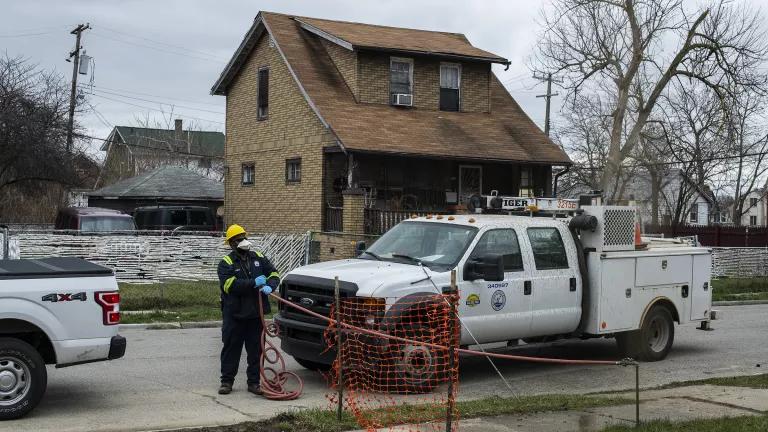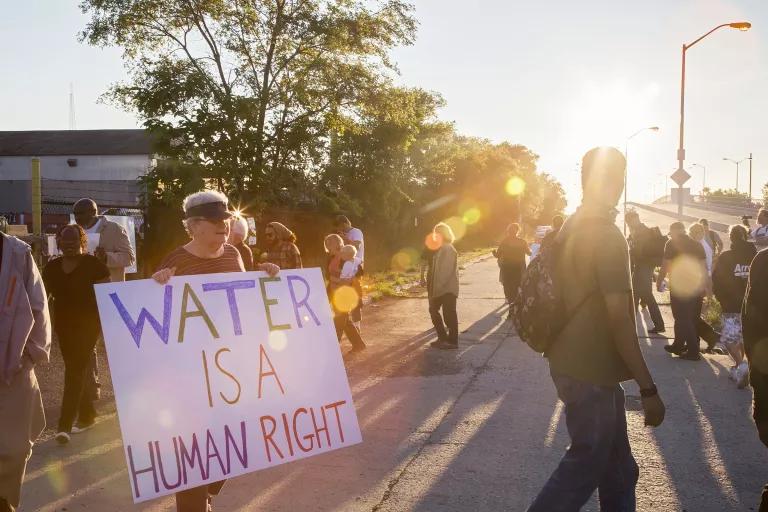The Fight for Equitable Access to Water and Electricity Has Never Been More Urgent
In the midst of a pandemic, NRDC advocates are stepping up their work to prevent the risk of mass utility shutoffs, now and for the long-term.

Workers restore water lines in Flint as a result of the COVID-19 crisis.
Back in March, when U.S. public health officials began advising handwashing as the first line of defense against COVID-19, they likely weren’t picturing the hundreds of thousands of people across the country who lacked running water. And when they encouraged social distancing and transitioning to online school, they may not have thought of families living in homes where electricity had been shut off.
“These affordability issues were already simmering in the background…and then COVID hit,” says Mae Wu, who has advocated for access to safe and affordable drinking water at NRDC for 13 years. Now, with one in five American workers filing for unemployment since mid-March, the risk of mass utility shutoffs has skyrocketed—just as residents need these basic services the most.
To protect the public’s health, NRDC has been urging governors, utilities, and Congress to ban utility disconnections. By mid-May, 15 states plus the District of Columbia and Puerto Rico established moratoriums on water shutoffs (although some were scheduled to expire by early June). Thanks in part to pressure from more than 17,000 NRDC members who’ve sent letters to their elected officials, several governors have not only banned water shutoffs but, in some cases, required safe reconnections for all occupied homes and offered emergency water in the interim as well.
Numerous public and private electricity providers have also responded to these calls for preventing service disconnections during the crisis. Among those who stepped up were all members of the Edison Electric Institute, the trade association representing private utilities that provide electricity for two-thirds of Americans.
In addition to helping secure immediate relief, NRDC continues to fight for long-term investments in both repairing our national water infrastructure and building or retrofitting higher-quality, more energy-efficient homes—particularly for those who bear the largest energy burdens.
Since 2018, NRDC’s Deron Lovaas has led the Energy Efficiency for All program, which brings together coalitions in 12 states to advocate for residents of low-income housing. Almost half of the 10 million affordable multifamily units in the United States were built at least 50 years ago, and many are in desperate need of upgrades to drafty windows, inefficient lighting, and outmoded heating and AC systems, among other aging appliances. Such improvements not only lower bills but they can also reduce greenhouse gases and benefit indoor air quality, which is particularly important during health crises like COVID-19. To date, the program has helped more than 200,000 renters across the country.
“The impact is substantial,” Lovaas says. “Low-income people pay a big chunk of their household budgets on energy bills, so it’s like a regressive tax.” Families must often choose between keeping the power on and other essentials, like putting food on the table or refilling prescription medicines. As a result of this burden, one in three American households are considered energy insecure and face extreme difficulty in paying their utility bills or maintaining adequate heating and cooling in their homes. The pandemic has reinforced the importance of delivering energy efficiency for all, to help make these basic costs of living manageable over the long-term.
A Case Study in Inequality
In few U.S. cities is the burden of high utility bills more apparent than in Detroit, which conducted the largest residential water shutoff in the country’s history in 2014. Since then, some 140,000 local residents have faced water shutoffs due to skyrocketing water rates, a 35 percent poverty rate, and what the ACLU dubbed “sloppy billing practices” by the Detroit Water and Sewerage Department. Though COVID-19 has brought this crisis to a head, NRDC has been working with the local People’s Water Board coalition since 2017 to champion solutions such as income-based water rates, more sustainable payment plans, or a redistribution of infrastructure costs to the wealthier Detroit suburbs.
“There’s a misperception that people just don’t want to pay,” says Cyndi Roper, an NRDC policy expert who’s worked on drinking water issues in the Great Lakes state for 25 years. “But when you look at the extraordinarily high bills, the reason for the water shutoffs is clear.” According to a recent National Public Radio report, Detroit residents pay, on average, a whopping $1,151 for water annually. In contrast, residents in Phoenix, which pipes most of its water from 300 miles away, pay about $400 annually.
The public health risks of utility shutoffs are grave, with or without a pandemic compounding the problem. The United Nations recognizes access to clean water and sanitation as human rights—without it, basics like personal hygiene, cooking, and food sanitation become nearly impossible. Residents without water will face even greater challenges in summer months as the heat soars and the risks of dehydration and heat stroke grow.
Allowing pipes to sit without running water for extended periods of time can also increase dangerous exposure to pathogens and toxic metals like lead when the water service is later restored. (To mitigate those risks, NRDC has pushed for safety measures like pipe flushing and repairs prior to reconnections during COVID-19.)
Nicole Hill, a Detroit resident and longtime advocate for affordable water, says the shutoffs have impacted her mental health as well. “Living with the fear of losing your children to Child Protective Services, or the stigma and stereotypes of the supposed spending habits, or never knowing the circumstances accounting for why my water bills are so high, is very frustrating,” she said in a recent press conference hosted by the People’s Water Board.
Activists like Hill have been working to highlight the link between public health and the lack of running water for years, Roper adds. “It took a global pandemic for the obvious to become front and center in Michigan.”
Much like the water crisis in neighboring Flint, where NRDC helped secure a settlement to address the city’s sky-high lead levels, the water crisis in Detroit is rooted in racism and inequity. After World War II, white families began moving out of Detroit en masse, leaving predominantly Black communities to pay for the massive, aging infrastructure of the water system serving a population reduced by half. Subsequently, rates soared.
“As the suburbs sprawled, you had fewer people paying for the oldest infrastructure in the region and [city officials] just haven’t been able to keep up with the upgrades,” Roper says. “There is a disproportionate allocation of these costs to Detroit residents, who are the least able to afford these expenses.”
Thanks to the dogged advocacy of both the People’s Water Board and its allies, including NRDC, Governor Gretchen Whitmer helped relieve the most immediate burdens on Michiganders in March by issuing the strongest protections in the country against shutoffs. The order ensured reconnections for all occupied homes, no matter how long they’d been disconnected, the distribution of emergency bottled water supplies for cooking and drinking, and $2 million for reconnections that will require repairs in order to make the tap water safe again.
Setting a New Precedent
Though advocates continue to work to ensure Whitmer’s executive order is carried out in full by the utilities, the move sets a high bar for the rest of the country. As Roper notes, it also reminds those in power of the injustices that so many people endure and the imperative to make change. “There is really a heightened sense of awareness that there are people living in Michigan without running water,” Roper says, “because there has been coverage of the issue in a way that has never been done before.”
Meanwhile, on the federal level, NRDC is lobbying extensively to include a shutoff ban in the next congressional stimulus package to provide some relief for the millions of Americans who still remain at risk of utility shutoffs in these devastating times. Roper and her colleagues are also helping to refine legislative proposals to create long-term protections for residents nationwide.

Those measures are essential to prepare for a healthier and greener future, adds Lovaas, whatever may arise. He likens the pandemic to what has been called a “gray rhino” event—“things that come charging at you that you should see coming, but you freeze and don’t act on soon enough.” Inevitably, “there will be more gray rhinos coming down the road,” he cautions—but with the right investments and policies in place, we can ready ourselves to meet them head-on.
This NRDC.org story is available for online republication by news media outlets or nonprofits under these conditions: The writer(s) must be credited with a byline; you must note prominently that the story was originally published by NRDC.org and link to the original; the story cannot be edited (beyond simple things such as grammar); you can’t resell the story in any form or grant republishing rights to other outlets; you can’t republish our material wholesale or automatically—you need to select stories individually; you can’t republish the photos or graphics on our site without specific permission; you should drop us a note to let us know when you’ve used one of our stories.

Causes and Effects of Lead in Water
What Can We Do to Fix the Drinking Water Problem in America?
Is Water a Human Right?